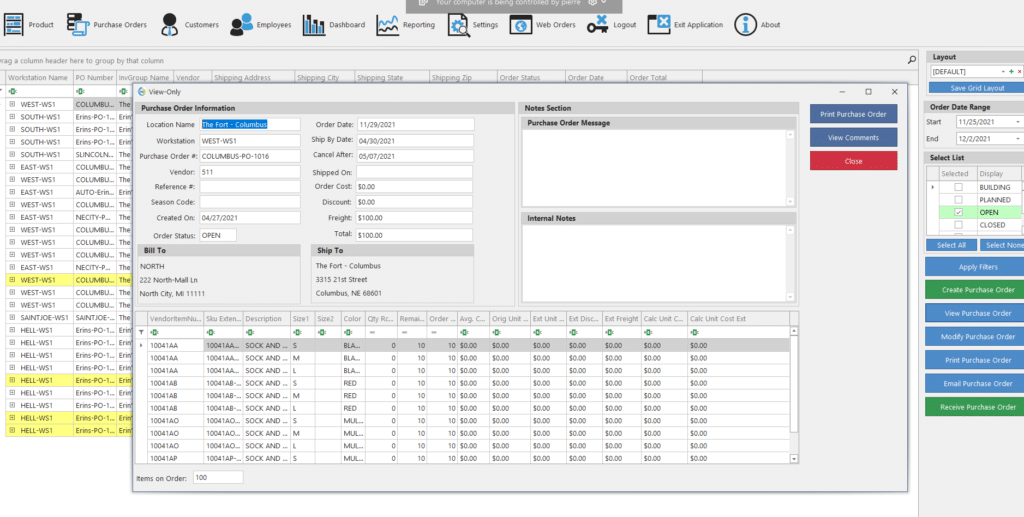Purchasing
Intelligent Purchasing for the Enterprise

Purchasing Made easy
Flexible and accurate purchasing for your locations
A purchase order begins life as a purchase request.
When you create a new purchase request, you specify the vendor you’re ordering from and the location you want the merchandise shipped to, as well as other details, including the shipping method and free on board (FOB) destination.
Add the items you’re ordering, including the quantity, unit, and unit cost, or use the purchasing worksheet to add multiple items to the purchase request simultaneously.
When you post a purchase request, it’s converted into a purchase order – which you can print or send to the vendor via e-mail – and on-order quantities are automatically updated.
Stock Request could also be a request to stock by each store manager for their specific location which can be converted to a purchase order. Portable barcode scanners could be used to tag items requested and imported into a purchase order document easily.
MULTI-STORE PO'S
Create multi-store purchase orders for multiple locations from an easy to use step by step wizard, set allocations by percentage or qty.
VENDOR RETURNS
Returns to vendors (RTVs) may be entered, reviewed, and posted to record the return of merchandise to vendors. RTVs reduce on-hand inventory and are recorded in Defective columns and may be recorded as credits with a vendor.
VENDOR MANAGEMENT
Track address and contact information, terms, shipping method, and receiving/purchase order details for each vendor. Create vendor item records that track the cost, purchasing unit, minimum order quantity, for each item you buy from a particular vendor. Track the primary vendor and any number of alternate vendors for each item along with their vendor specific costs.
QUANTITY ADJUSTMENTS
After merchandise is received, you can create quantity adjustments to correct received cost and miscellaneous charge values for individual receiving order, allowing you to update your inventory and costs of goods sold.
PURCHASE ORDER IMPORTS
Import Purchase orders from external order systems like JOOR, NU ORDER, FAIRE & Elastic. external files in .csv or .txt comma delimited or tab delimited formats. saving you many hours from manual data entry. Any new SKU is added to the system and any existing SKU gets the PO QTY updated.
STYLE GRID PURCHASE ORDERS
Easily view styles within a style group. You can instantly see size1, size2, and color along with the quantities needed to make purchasing decisions. Total Company Quantity, Location Quantity, Quantities On Order for Company and Location, and Sales Quantities are all visible and accessible in one easy to read grid. Pivot grid elements like color, size1, size2 and other elements can be moved around to get the perfect layout for your use, additionally each element can be filtered and grouped on the fly.
AUTO PO'S GENERATION
Auto PO calculates suggested reorder quantities and automatically generates purchase orders for your items, using one Min/Max Levels available at each stocking location including warehouses. Replenishment method orders enough of each item to replace the quantity sold during a specific period, allowing you to specify a fill to MIN or Max values; the Maximum method identifies items that have fallen below their minimum reorder quantities and orders enough to bring up stocking levels to their defined maximums. Auto PO calculates reorder quantities based on a variety of factors, including current inventory levels, committed quantities, backorders, in-transit merchandise, open purchase orders, and vendor minimums. You can generate Auto PO’s, and the resulting purchase orders, for your primary vendors or for a single vendor.
FREIGHT & DISCOUNT SPREAD
Accurately spreads the Total Freight & Discounts cost PROPORTIONATELY (based on qty of each line item) to achieve the most accurate average cost.
RECEIVING
Receive merchandise with or without a purchase order. During receiving, you can retrieve purchase orders by PO number, vendor, or any other criteria. You can receive each PO in full or partial, backordering or cancelling the balance un-received lines. You can even add new lines to a receiving order to account for additional merchandise that was shipped with an order. Portable barcode scanners could be used to tag items during receiving and imported into a receiving document easily.
CUSTOM ORDERS
Customer-specific purchasing allows you to review open customer orders that were entered at the point of sale and automatically generate purchase orders for the items you need to fulfill those orders. You can create a single purchase order for each vendor, each of which can include items from multiple customer orders, or a separate purchase order for each customer.
